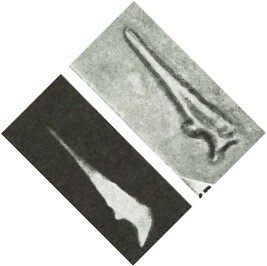Orthorhabdus serratus
Set number: 1660
-
1
-
2
-
3
-
4
-
5
-
6
-
7
-
8
-
9
-
10
-
11
-
12
-
13
-
14
-
15
-
16
-
17
-
18
-
19
-
20
-
21
-
22
-
23
-
24
-
25
-
26
-
27
-
28
-
29
-
30
-
31
-
32
-
33
-
34
-
35
-
36
-
37
-
38
-
39
-
40
-
41
-
42
-
43
-
44
-
45
-
46
-
47
-
48
-
49
-
50
-
51
-
52
-
53
-
54
-
55
10µm
in mobile mount
Set number: 1663
-
1
-
2
-
3
-
4
-
5
-
6
-
7
-
8
-
9
-
10
-
11
-
12
-
13
-
14
-
15
-
16
10µm
Set number: 1662
-
1
-
2
-
3
-
4
-
5
-
6
-
7
-
8
-
9
-
10
-
11
-
12
-
13
-
14
-
15
-
16
10µm
Set number: 1661
-
1
-
2
-
3
-
4
-
5
-
6
-
7
-
8
-
9
-
10
-
11
-
12
-
13
-
14
-
15
-
16
-
17
-
18
10µm
Set number: 477
-
1
-
2
-
3
-
4
-
5
-
6
-
7
-
8
-
9
10µm
Orthorhabdus serratus Bramlette & Wilcoxon, 1967
The mobile mount reveals that blades in Orthorhabdus are at equal angles to each other (plate 8, Figures 9-16 in Varol, 2025). The side view displays an inclined (oblique) extinction (Plate 9, Figures 3, 7, 9, 12-13, 16 in Varol, 2025); the extinction angle varies depending on how the “toe” of the hockey stick faces. The extinction angle is about 20° in the side view when the toe is directed to the left (Plate 9, Figures 3, 7 in Varol, 2025). In the plan view, Orthorhabdus appears in constant extinction (with the optic axis vertical to the microscope stage in this orientation, Plate 8 Figs. 1-3, 5-7 in Varol, 2025). Orthorhabdus serratus differs from the other taxa in the family Triquetrorhabdulaceae by having blades truncated at one end and pointed at the other. Orthorhabdus serratus also differs in that it has an inclined optic axis and exhibits length-slow (+) elongation at the side view.
Bramlette, M. N. & Wilcoxon, J. A. 1967. Middle Tertiary calcareous nannoplankton of the Cipero section, Trinidad, W.I. Tulane Studies in Geology and Paleontology 5: 93-131.
Gartner, S. 1967a. Calcareous nannofossils from Neogene of Trinidad, Jamaica, and Gulf of Mexico. University of Kansas Paleontological Contributions, Papers 29: 1-7.
Martini, E. 1965. Mid-Tertiary calcareous nannoplankton from Pacific deep-sea cores. Colston Papers 17: 393-411.
Varol, O. 2025a. A practical guide to optical studies of calcareous nannofossils. Grzybowski Foundation Special Publication. 29: 1-222
